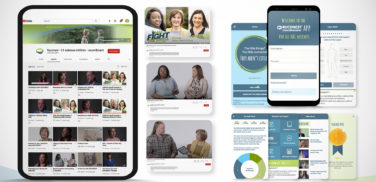The ongoing global pandemic and associated loss of life illustrates the important need to advance health literacy of people around the world. The opportunity speaks loudly in that health literacy could and should be incorporated in nearly every aspect of the response to COVID-19; especially across public health and healthcare systems as well as the biopharmaceutical industry. This need spans across populations, from those experiencing the worst social inequities in health, environment, income, and education to those living with the very best social benefits of those same areas. Simply stated, everyone benefits.
The Importance of Health Literacy During a Pandemic
Clear, evidence-based communication about COVID-19 prevention and care is needed for individuals, families, communities, and government in order to facilitate informed decisions that will help prevent further spread of the virus. This includes the often repeated but inconsistent practice of wearing masks, hand hygiene, physical distancing, and avoiding crowds. It also includes understanding the available testing options for COVID-19 current and past infection status. These are complex topics, but the opportunity exists to augment comprehension through the use of clear, simple, and accurate information.
Another key opportunity is to develop clear messaging about potential vaccines such as addressing the research and clinical trial process, the timelines that are reasonable, and the paramount importance of safe and effective vaccines for COVID-19. Recent surveys have found that nearly half of Americans polled are hesitant to take the vaccine once it is approved for use.
The biopharmaceutical industry also has a distinct role to prioritize health literacy and incorporate the patient voice. While public perceptions and understanding of the industry vary widely, the industry can benefit from adopting health literacy principles that address the aspects of vaccine development, timelines, safety, and efficacy. A deliberate effort to ensure the highest comprehension across diverse populations may enhance trust between society and the healthcare sector, lead to greater acceptance and uptake of approved vaccines, and result in a slowing of the virus transmission across the globe.
Bringing Patients into the Process
The opportunity before us is to seek out and listen to patient voices throughout the clinical development process, and to support health literate information and communications that take place between patients and their health providers once vaccines and treatments receive the U.S. Food and Drug Administration’s (FDA) approval. By including patient experiences and preferences throughout the concept, development, approval, and reporting processes, we have the ability to show respect to our end users, better understand how to safely use these potential products, improve understanding of the research and clinical trial processes, and increase more diverse participation in clinical trials.
Special attention to engaging diverse populations—the elderly, un/underinsured, vulnerable populations, those at higher risk of poor outcomes, individuals who speak English as a second language, etc.—is crucial and will ensure that the industry incorporates insights and lessons learned from a broad and real-world representation of our societies. If we do a better job recruiting diverse populations, we will have a clearer understanding of how medicines and vaccines may have a different safety and efficacy profile for people of Black, Hispanic, or Asian descent, for instance.
The FDA recognizes the importance of incorporating the patient perspective and experience into the clinical trial process. The FDA has conducted listening sessions for more than 20 disease areas and established a Patient Engage Collaborative. Other efforts at the FDA include a Patient-Focused Drug Development initiative.
The Impact of Engaging Diverse Communities
While progress has been made, much work is still to be done. That starts with ensuring participants in clinical trials represent those who make up society—and explicitly include under-represented and vulnerable populations. This means reaching out in respectful ways to patients with the lowest health literacy and who often experience the greatest sense of disempowerment.
Engaging with diverse communities of patients earlier and more often in clinical trials will:
- Aid companies in understanding what outcomes are relevant to patient communities.
- Develop and obtain clear informed consent in respectful ways.
- Determine what language to use.
- Support more convenient and flexible ways to participate.
- Collect meaningful patient experiences that facilitate clinical trial completion.
- Create relevant patient information and user-focused packaging.
Additionally, engaging patients early and often provides the best methods for mutual learning, adaptation, and shared decision-making to transform and develop relationships built on mutual respect and appreciation.
We began this article with a focus on the biopharmaceutical industry’s need to fully embrace health literacy. We postulate that such an action will result in benefits to the industry, patients, and public health, including an increase in diverse participation and retention in clinical trials. This will also contribute towards improved patient and caregiver understanding of the safety and efficacy of medicines and vaccines.
Progress is being made at the global level, as demonstrated by the Shanghai Declaration of 2016. One outcome of the World Health Organization’s 9th Global Conference on Health Promotion was to prioritize health literacy as one of the key strategies to reach the Sustainable Development Goal targets. These goals lie at the heart of the United Nations’ effort to lead the world toward sustainable development. Reaching all these goals requires coordinated and sustained partnerships between all sectors and all levels of society—business, government, civic organizations, and patient communities.
COVID-19 reminds us of the vital role that health literacy plays in achieving population health goals—whether at the country or global level. Across the healthcare sector we can work together to embrace, activate, and incorporate the value of the patient experience. By incorporating health literacy principles into the many dimensions of research and development, clinical trial processes, marketing communications, and patient education materials, we empower patients and give them voice.
Laurie Myers, MBA, Global Health Literacy Director at Merck and Andrew Pleasant, PhD, Senior Advisor on Health Literacy Interventions, Research, and Evaluation at Health Literacy Media also made significant contributions to this article.









